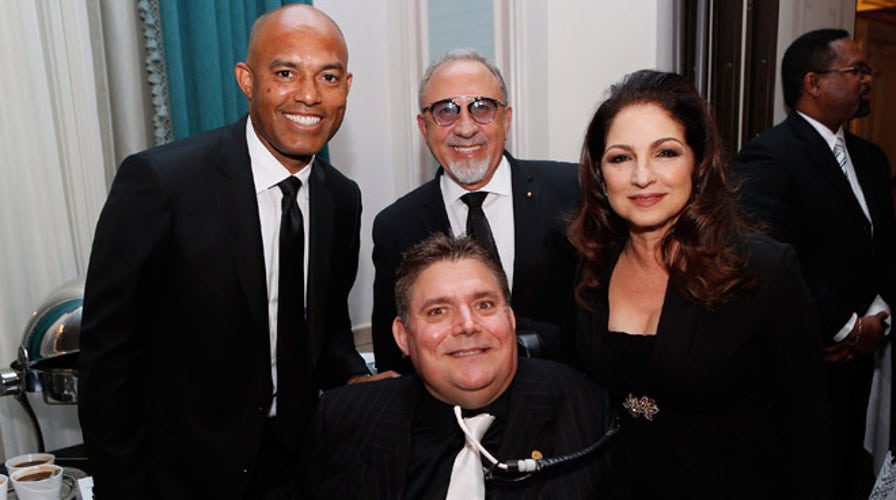Gloria Estefan, Mariano Rivera join fight against paralysis
Singer Gloria Estefan and Yankee great Mariano Rivera were among those who came out to support the Buoniconti Fund to Cure Paralysis.
Gloria Estefan's world collapsed in 1990.
A semi truck traveling near Tobyhanna, Pennsylvania, jack-knifed, and when Estefan’s tour bus stopped to avoid colliding with it, another truck slammed into the bus. The accident threw the singer, then 32, forcefully to the floor. Estefan suffered a broken back, and doctors feared she would never walk again.
“I vowed that I would do whatever I could in my lifetime to help find a cure,” Estefan said Monday night in an interview with Fox News Latino at a Manhattan event to benefit the Buoniconti Fund to Cure Paralysis.
Dr. Harry Schmaltz, who treated Estefan at the time, told reporters: "Another half-inch of movement of the spine, she'd be completely paralyzed."
Estefan fought through painful physical therapy and multiple surgeries, eventually making a remarkable recovery. With metal rods implanted in her spine, she returned to her high-octane stage performances, singing and dancing up a storm and keeping a hectic schedule.
“I’m really on the very lucky side,” the singer told FNL.
Estefan was participating in an annual dinner at the Waldorf Astoria Hotel to benefit research efforts and to find a cure for paralysis from spinal cord injuries.
She was one of several celebrities taking part in the Buoniconti Fund event, which is part of the Miami Project to Cure Paralysis. The benefit dinner – which each year draws scores of celebrities and leaders from various fields – honored former Yankees closer Mariano Rivera, among other sports figures.
“It means a lot to me,” Rivera told Fox News Latino about being honored by the Fund. “It does so much good for people. When you have people trying to help those [who] are in need, especially with research … it’s wonderful to be part of it.”
The Fund is named after NFL Hall of Fame linebacker Nick Buoniconti, who starred for the Miami Dolphins teams of the 1970s. Buoniconti's son, Marc, was a linebacker at Citadel college who dreamt of having a career like his father's when he went to make a tackle against East Tennessee State.
“I made a tackle,” Marc Buoniconti told CNN in 2007, “and the next thing I know, I fell to the turf like a ton of bricks … I knew right away that I was paralyzed.”
He became a quadriplegic, and a mission began for his father.
“Nick Buoniconti [was] promising his son that he would help find a cure and get him out of the chair,” Estefan said. “Being in Miami and being a huge Dolphins fan and a Buoniconti fan, I gravitated toward them and vice-versa.”
Estefan teamed up with Dr. Barth Green, a prominent spinal cord specialist in South Florida, and became active in the Buonicontis effort to help find a cure and raise awareness about spinal cord injuries.
Green, the Buonicontis and others launched the Miami Project to Cure Paralysis.
The Gloria Estefan Foundation has given million-dollar gifts to the Miami Project, and she has served on the Buoniconti Fund’s board of directors. As chairperson, she helped raise $50 million to establish the Lois Pope LIFE Center at the University of Miami, which houses the Miami Project.
“We’re in five human trials already, we’re very close to finding a cure,” Estefan told FNL. “We’ve been able to bridge the spinal cord to the nerve, and gotten 80 percent of motor function back in a severed cord of a primate.”
Green’s involvement, she said, has been crucial to the research for a cure.
“I would have gone to Barth Green” for treatment, Estefan said about her accident, “but it was too far. They couldn’t move me.”
“For more than 30 years, The Great Sports Legend Dinner has highlighted our incredible journey to raise funds and bring awareness to the ground-breaking, much-needed spinal cord injury research supporting our efforts to cure paralysis,” Nick Buoniconti said in a statement about the Waldorf Astoria event. “We’re honored to have the generosity and participation of so many iconic athletes and heroes who join us in providing hope for those living with paralysis, so together we can stand up for those who can’t.”
Today the Miami Project’s international team includes more than 300 scientists, researchers, clinicians and support staff working on ways to address spinal cord and brain injuries.
“It really important to try to help it along and it won’t just be for paralysis but it’ll be for any neurological disease or issues,” Estefan said. “They’re going to be helped very much by this research, and I’m just happy to do what I can to help keep it going.”






















